Decor
What Does Decoration Day Mean

In the past, Decoration Day was observed as a solemn event dedicated to honoring those who sacrificed their lives for our nation. Over the years, the meaning of Decoration Day has transformed, and with its evolution into Memorial Day, the way we celebrate and remember our fallen heroes has also changed.
Join us as we explore the origins, traditions, and contemporary observance of this important day, and discover what it truly means to honor those who have bravely served our nation.
Key Takeaways
- Decoration Day, later known as Memorial Day, originated in the aftermath of the American Civil War as a way to honor and commemorate fallen soldiers.
- The traditions and customs associated with Decoration Day include laying wreaths, flying the American flag at half-mast, visiting cemeteries to decorate graves, and expressing appreciation for the sacrifices made by servicemen and women.
- The observance of Memorial Day has evolved to encompass all military personnel who have died in service, and now includes activities such as educational programs, parades, and community events.
- Memorial Day holds historical significance and personal impact, as it recognizes the enduring impact of fallen heroes on the nation's history and collective consciousness, and encourages reflection on the profound influence of individuals and the importance of gratitude and remembrance.
The Origins of Decoration Day
The origins of Decoration Day can be traced back to the aftermath of the American Civil War, where communities across the nation sought to honor and commemorate the sacrifices of the fallen soldiers. This historical significance lies in the collective need to memorialize the immense toll of the war and to provide a sense of closure for the communities that were deeply affected by it.
As a result, various towns and cities began holding ceremonies and decorating the graves of the fallen with flowers and flags. This communal expression of grief and gratitude eventually led to the establishment of Decoration Day, which later evolved into the modern Memorial Day.
The origins of Decoration Day reflect a pivotal moment in American history, showcasing the profound impact of the Civil War on the nation's collective consciousness. The tradition's roots underscore the deep sense of loss and the enduring gratitude for the sacrifices made by those who fought in the war.
Understanding the origins of Decoration Day provides a poignant insight into the ways in which communities come together to honor their fallen heroes and commemorate the historical events that have shaped their shared identity.
Evolution Into Memorial Day
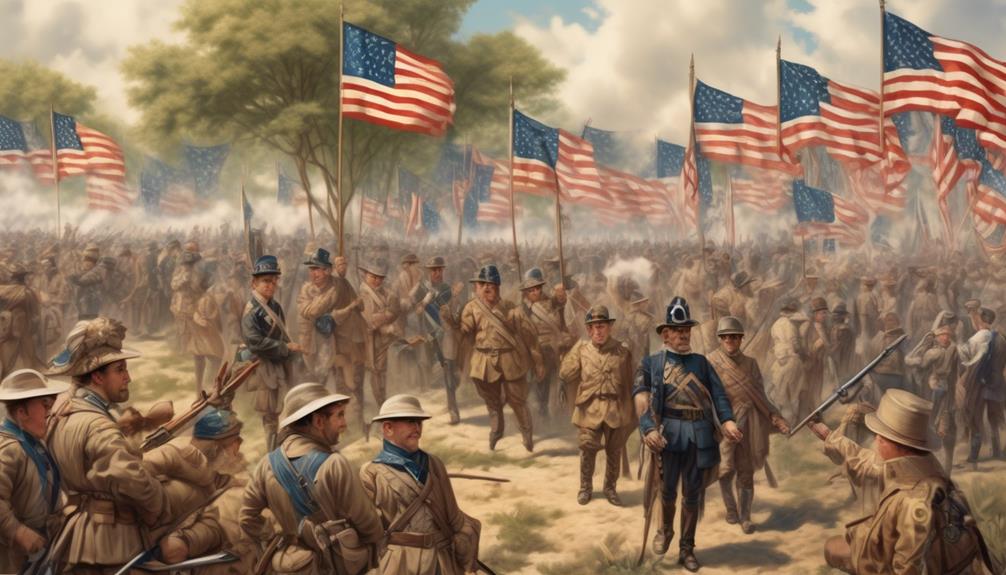
With time, Decoration Day evolved into the modern Memorial Day, becoming a nationally recognized occasion for commemorating the sacrifices of fallen soldiers and honoring their enduring legacy. This evolution holds historical significance, reflecting the changing attitudes towards honoring those who gave their lives in military service.
The transformation from Decoration Day to Memorial Day wasn't just a change in name, but a shift in the day's purpose and broader cultural significance.
- National Observance: Memorial Day became a federal holiday in 1971, marking its official status as a day of remembrance for fallen soldiers.
- Expanding Commemoration: The evolution from Decoration Day expanded the focus to encompass all military personnel who've died in service, reflecting the changing landscape of warfare and the diverse roles individuals play in the armed forces.
- Cultural Traditions: The evolution into Memorial Day brought about new traditions, such as the National Moment of Remembrance and the widespread practice of visiting cemeteries and memorials.
- Educational Significance: Beyond being a day off from work, Memorial Day has evolved to include educational activities, parades, and community events that serve to teach younger generations about the sacrifices made by those in the military.
As Memorial Day continues to evolve, it remains a day to honor and remember the courage and selflessness of those who've given their lives in service to their country.
Traditions and Customs
Observing the customs and traditions of Memorial Day provides a poignant and meaningful way to honor the sacrifices of our fallen heroes. Symbolic practices like the laying of wreaths, flying the American flag at half-mast until noon, and visiting cemeteries to decorate the graves of veterans are deeply ingrained in the cultural significance of Memorial Day. These customs serve as a visible reminder of the valor and selflessness of those who gave their lives in service to our nation.
Participating in these traditions allows us to engage with the solemnity and reverence of the day, fostering a collective sense of remembrance and gratitude. It's a time-honored way to express our appreciation for the freedoms we enjoy today, made possible by the bravery and dedication of our servicemen and women. By upholding these customs, we not only pay tribute to the fallen, but we also demonstrate our commitment to preserving their legacies for future generations.
In essence, these symbolic practices are more than mere rituals; they embody the enduring spirit of Memorial Day, encapsulating the enduring gratitude and respect we hold for those who made the ultimate sacrifice.
Honoring the Fallen Heroes

In honoring the fallen heroes, we must recognize the enduring impact of their sacrifice on our nation's history and collective consciousness. Remembrance of their bravery and dedication is essential as we reflect on the significance of their contributions. The act of honoring these heroes extends beyond a single day or ceremony; it's a continual acknowledgment of the debt of gratitude we owe to those who made the ultimate sacrifice for our freedom and safety.
- Memorial: Every memorial, whether grand or humble, stands as a testament to the lives lost in service to our country. These memorials provide physical spaces for reflection and serve as focal points for collective remembrance.
- Gratitude: Expressing gratitude for the sacrifice of fallen heroes isn't just a personal sentiment, but a national duty. It fosters a sense of unity and solidarity, reminding us of the values and freedoms that we hold dear.
- Impact: The impact of honoring fallen heroes goes beyond individual grief. It serves as a reminder of the price of freedom and the resilience of the human spirit in the face of adversity.
- Legacy: Each fallen hero leaves behind a legacy that shapes our nation's identity. Their sacrifice becomes a part of our collective narrative, inspiring future generations to uphold the principles for which they fought and died.
Contemporary Observance and Reflection
A contemporary approach to commemorating Decoration Day involves reevaluating its significance in the context of our evolving societal values and historical perspective.
In today's world, the observance of Decoration Day, now known as Memorial Day, has expanded to honor not only the fallen soldiers but also all loved ones who've passed away. This contemporary commemoration reflects a shift towards inclusivity and a broader recognition of personal impact. It prompts us to consider the profound influence of individuals beyond their roles as soldiers, recognizing their multifaceted identities and the lasting impressions they leave on our lives.
In our modern reflection on Decoration Day, we're encouraged to explore the personal impact of loss and sacrifice. While we collectively honor the bravery and dedication of those who served, we also acknowledge the individual stories and connections that define their lives. This contemporary observance fosters a deeper understanding of the human experiences intertwined with this day, allowing for a more intimate and reflective approach to commemoration.
As we navigate the complexities of our changing world, this modern perspective invites us to honor the past while embracing the present, finding resonance in the enduring legacy of Decoration Day.
Frequently Asked Questions
How Has the Meaning of Decoration Day Changed Over Time?
Over time, the meaning of Decoration Day has changed as traditions evolved and its significance shifted.
It's fascinating to see how this day, originally dedicated to honoring fallen soldiers, has expanded to commemorate all loved ones who've passed.
The rituals and customs associated with Decoration Day have adapted to reflect the evolving cultural and social landscape, showcasing the enduring human need to remember and honor the departed.
Are There Any Specific Regional Differences in How Decoration Day Is Observed?
In observing Decoration Day, we've noticed specific regional differences in customs and traditions. It's fascinating to see how various communities across the country have their unique ways of honoring and remembering the fallen.
These regional distinctions reflect the diverse cultural and historical influences that have shaped the observance of Decoration Day. Understanding these differences adds depth to our appreciation of this important day of remembrance.
What Are Some Lesser-Known Customs or Traditions Associated With Decoration Day?
Well, there are some lesser-known customs and traditions associated with Decoration Day that are quite fascinating.
For example, some communities have unique mourning practices that involve creating intricate floral arrangements to honor the deceased.
Symbolism also plays a significant role, with certain flowers and colors holding specific meanings.
These memorial traditions offer a deeper insight into the diverse ways in which people commemorate their loved ones.
How Do Families Typically Honor Their Loved Ones on Decoration Day?
On Decoration Day, families typically honor their loved ones by visiting their gravesites and adorning them with beautiful floral arrangements. It's a time for us to come together in family gatherings, sharing stories and memories of those we've lost.
Many also attend memorial services to pay tribute to the departed. It's a deeply meaningful tradition that allows us to show our love and respect for our beloved departed family members.
Are There Any Important Historical Figures or Events Related to the Establishment of Decoration Day?
Important historical figures and events related to the establishment of Decoration Day include:
- General John A. Logan, who played a key role in its establishment after the Civil War.
The day evolved into Memorial Day, signifying the historical significance of honoring fallen soldiers.
Various traditions and customs developed over time, influenced by regional differences.
These customs provide a personal and intimate way for families to remember and honor their loved ones who served.
Is “Decoration Day” the Same as Memorial Day?
Decoration Day and Memorial Day have separate origins, but they both share the same purpose of honoring those who have served in the military. The history of Decoration Day dates back to the post-Civil War era, while Memorial Day officially became a federal holiday in 1971.
Conclusion
In conclusion, Decoration Day, now known as Memorial Day, has a rich history and tradition of honoring fallen heroes.
It's interesting to note that according to the National Retail Federation, Americans spent over $7 billion on food and beverages for Memorial Day weekend in 2020, showing the significance and observance of this holiday.
As we continue to reflect and honor those who've made the ultimate sacrifice, let's also remember the true meaning behind this day of remembrance.
- About the Author
- Latest Posts
Introducing Ron, the home decor aficionado at ByRetreat, whose passion for creating beautiful and inviting spaces is at the heart of his work. With his deep knowledge of home decor and his innate sense of style, Ron brings a wealth of expertise and a keen eye for detail to the ByRetreat team.
Ron’s love for home decor goes beyond aesthetics; he understands that our surroundings play a significant role in our overall well-being and productivity. With this in mind, Ron is dedicated to transforming remote workspaces into havens of comfort, functionality, and beauty.
Eclectic Style
Hello, Gorgeous! The Spanish Architectural Secret That's Too Hot for Siestas!
Knock on the door of Spanish architecture's scorching secret – discover how 'Azulejos' tiles and thick walls beat the heat in style.

Embark on a lively adventure through Spanish architecture, where 'Azulejos' tiles resist the scorching sun with Moorish charm. Thick walls protect against the heat, while small windows welcome cool shadows into courtyards. Admire the fusion of beauty and function in structures that stand as proof of centuries of cultural heritage. Immerse yourself in the world of intricate patterns and historical motifs that decorate Spanish buildings, highlighting a mix of Islamic, Moorish, and Spanish influences. You'll uncover the secrets behind the aesthetic attraction and practical durability of Spanish architecture in the Mediterranean heat.
Key Takeaways
- Thick walls and small windows provide insulation and shade against intense heat.
- Courtyards offer cool retreats for relaxation and socializing in the warm climate.
- Spanish architecture uses clay tiles and stucco for heat reflection and insulation.
- Innovative design solutions in Basque Country enhance both aesthetics and functionality.
- The blend of aesthetics and functionality in Spanish architecture combats the intense heat effectively.
Architectural Beauty of 'Azulejos'
The architectural beauty of 'Azulejos' shines through in the vibrant and intricate designs that adorn Spanish and Portuguese buildings. These decorative ceramic tiles have been gracing walls, floors, and facades since the 13th century, adding a touch of color and history to the region's architecture.
As you stroll through the sun-soaked streets of Spain, you'll notice the mesmerizing geometric patterns, delicate floral motifs, and alluring historical scenes depicted on these tiles.
While taking a break during the famous Spanish Siesta, you can marvel at the artistry and craftsmanship that goes into each 'azulejo.' The blend of Islamic, Moorish, and Spanish influences creates a unique aesthetic that reflects the rich cultural heritage of the region.
From the Alhambra Palace to the streets of Seville, 'Azulejos' tell stories of conquests, traditions, and artistic prowess, making them a beloved feature in Spanish architectural design.
Moorish Influence in Spanish Architecture
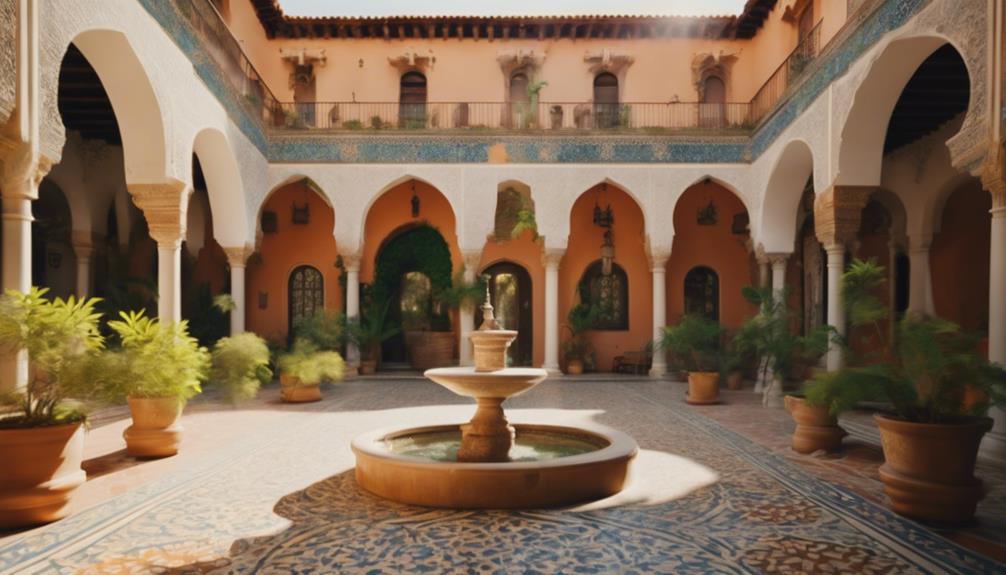
You'll discover the rich Moorish influence in Spanish architecture through intricate Islamic designs and striking geometric patterns. The Alhambra Palace, with its mesmerizing muqarnas and arabesques, serves as a prime example of this architectural style.
Modern Spanish adaptations continue to showcase the legacy of Moorish architectural origins in structures found throughout Spain.
Moorish Architectural Origins
Revealing the intricate origins of Moorish influence in Spanish architecture unveils a fascinating blend of design elements that have left a lasting imprint on the country's cultural landscape. Moorish architecture in Spain stems from the Islamic rule during the Middle Ages, introducing distinctive features like intricate geometric patterns, horseshoe arches, and ornate tile work.
This unique style can be observed in iconic landmarks such as the Alhambra Palace in Granada and the Mezquita in Córdoba. What makes Moorish architecture truly enchanting is its fusion of Islamic, Christian, and Jewish design elements, reflecting Spain's rich history of cultural diversity.
The legacy of Moorish architecture serves as a tribute to the country's past, showcasing a harmonious blend of different influences that have stood the test of time. By delving into the origins of Moorish architecture, one can truly appreciate the beauty and complexity of Spain's architectural heritage.
Intricate Islamic Designs
Delving into the world of intricate Islamic designs within Spanish architecture reveals a mesmerizing tapestry of geometric patterns and arabesques. Moorish architecture in Spain is renowned for its intricate details and breathtaking beauty. The Alhambra Palace in Granada stands as a prime example, showcasing exquisite Islamic designs that captivate visitors with their complexity and precision.
Moorish architects in Spain ingeniously incorporated elements like horseshoe arches and intricate tile work, creating a unique blend of Islamic and Spanish aesthetics. The influence of Islamic design can also be observed in iconic Spanish landmarks such as the Alcazar of Seville, where intricate patterns adorn the walls and ceilings, transporting you to a world of geometric sophistication.
Spanish cities like Cordoba boast stunning examples of Moorish architecture, with the Mezquita serving as a striking demonstration of the fusion of Islamic and Spanish architectural styles. The intricate Islamic designs found throughout Spanish architecture truly exemplify the beauty and intricacy of Moorish influence in the region.
Modern Spanish Adaptations
In modern Spanish architecture, Moorish influences are prominently seen through the incorporation of intricate patterns, arches, and geometric shapes. Spanish architects draw inspiration from Moorish architecture, evident in structures like the Alhambra Palace in Granada. This fusion of styles creates a fascinating blend, where traditional Moorish aesthetics meet contemporary design principles.
Moorish architectural motifs play a vital role in adding elegance and cultural richness to modern Spanish buildings. The use of ornate stucco work, horseshoe arches, and intricate tile mosaics reflects the intricate craftsmanship characteristic of Moorish design. These elements not only beautify the architecture but also evoke a sense of history and tradition.
Practical Functionality in Spanish Buildings
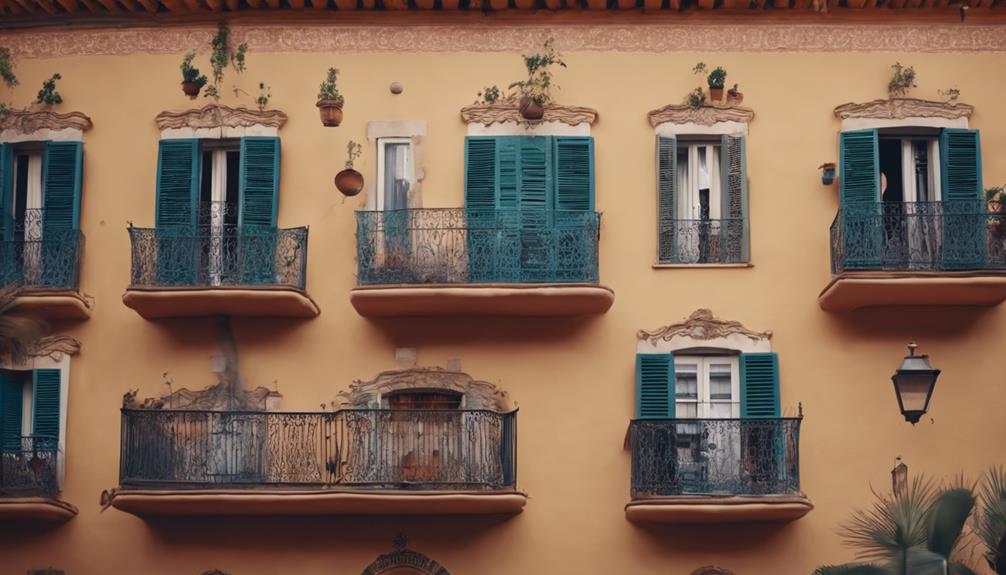
Spanish buildings are renowned for their incorporation of practical features to combat the heat and maintain a comfortable indoor temperature. The architectural design focuses on natural ventilation, shading, and thermal mass properties for energy efficiency. Courtyards and inner gardens are common elements in Spanish buildings, creating cool, shaded spaces that offer respite from the intense heat. Historical buildings in Spain showcase a blend of Moorish, Gothic, and Renaissance influences in their practical design. By utilizing thick walls, small windows, and clever positioning of openings, Spanish architecture adapts to the country's warm climate with finesse.
| Practical Feature | Description |
|---|---|
| Thick Walls | Provide insulation against heat |
| Small Windows | Reduce direct sunlight penetration |
| Courtyards | Create shaded, cool spaces |
| Thermal Mass Properties | Retain and release heat slowly for energy efficiency |
Vibrant Ceramic Tiles in Spain
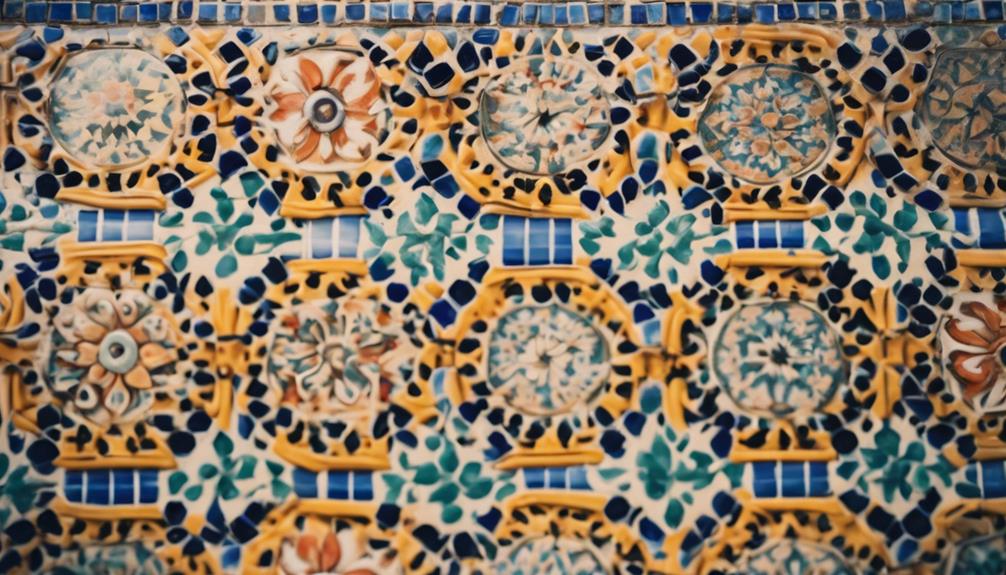
Brighten up your architectural journey through Spain with the vibrant ceramic tiles known as 'azulejos' that grace buildings, walls, and floors across the country. These intricate tiles, originating from Moorish influences in Spain, are characterized by their colorful designs and intricate geometric patterns.
Azulejos have become a defining feature of Spanish architecture, adding elegance and artistry to various structures. The tradition of using azulejos dates back centuries, showcasing a distinctive element of Spain's cultural and architectural heritage.
You can find these ceramic tiles in famous landmarks like the Alhambra Palace in Granada and the Park Güell in Barcelona, where they contribute to the timeless beauty of Spanish ceramic tile artistry. Whether adorning the façade of a building or lining the walls of a courtyard, azulejos bring a unique vibrancy and charm to the architectural landscape of Spain.
Make sure to keep an eye out for these stunning tiles as you explore the rich architectural tapestry of Spain.
Aesthetic and Functional Blend

Discover how Spanish architects expertly blend aesthetics and functionality to create visually stunning and purposeful structures. Spanish architecture is renowned for seamlessly integrating aesthetic beauty with practicality, a unique characteristic that sets it apart.
The architectural secret in Spain lies in the meticulous attention to detail, ensuring that every design not only pleases the eye but also serves a functional purpose. Spanish architects have honed their skills in harmonizing form and function, creating buildings that aren't only visually appealing but also highly usable.
The architectural style in Spain emphasizes the importance of both visual appeal and usability, striking a delicate balance between the two. This focus on the aesthetic and functional blend is what gives Spanish architecture its timeless allure and universal appreciation.
The beauty of Spanish architecture truly shines through its ability to elegantly merge aesthetics with purpose, creating structures that aren't just buildings but pieces of art that enrich the urban landscape.
Cultural Significance of 'Azulejos'
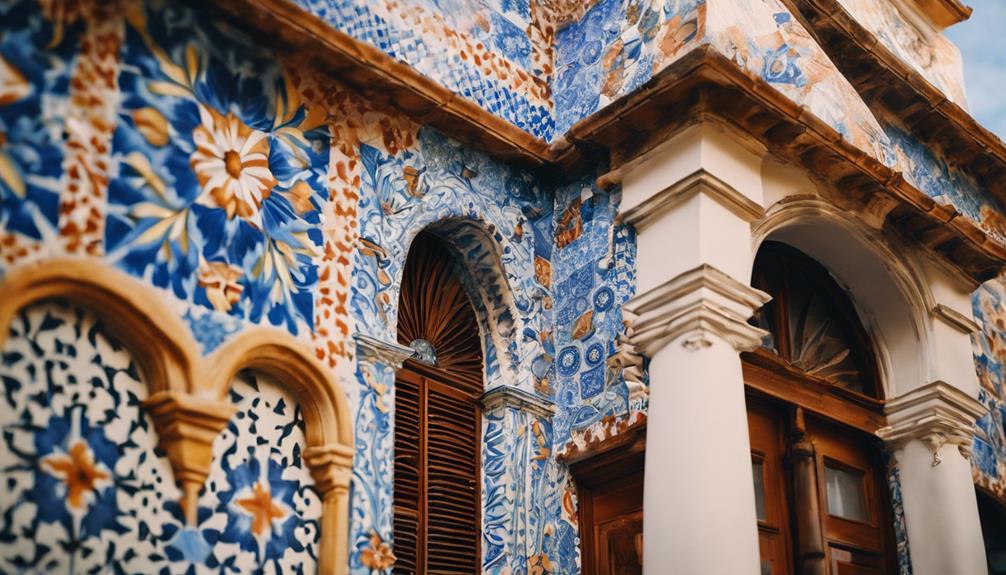
Traditional Spanish architectural design incorporates a unique feature known as 'Azulejos,' ceramic tiles that hold deep cultural significance. These tiles are a hallmark of Spanish architecture, adorning buildings with their exquisite designs. Azulejos aren't merely decorative elements; they're a reflection of Spain's rich cultural heritage and history.
The intricate geometric patterns, vibrant colors, and historical motifs found on azulejos are a tribute to the country's diverse influences, particularly from Moorish and Islamic designs dating back to the 13th century. The word 'azulejo' itself has its roots in Arabic, stemming from the term 'al zellige,' showcasing the cultural exchange between Spain and the Islamic world.
These ceramic tiles can be spotted on walls, floors, ceilings, and even fountains, adding a distinctive touch to Spanish buildings. As you explore Spanish architecture, keep an eye out for these mesmerizing azulejos that not only beautify the surroundings but also narrate stories of the past.
History of 'Azulejos' in Spain

Let's explore the fascinating history of 'Azulejos' in Spain, from their origins to their cultural significance and modern applications.
These decorative ceramic tiles have a rich heritage dating back to the Moorish influence in Spain, adorning various architectural wonders with their intricate designs and vibrant colors.
Understanding the evolution and importance of Azulejos sheds light on Spain's architectural identity and cultural legacy.
Azulejos Origins in Spain
Azulejos, colorful ceramic tiles with roots tracing back to the 13th century in Spain, were heavily influenced by Islamic art and architecture during the Moorish rule. These decorative tiles, deeply intertwined with Spain's history, reflect the fusion of Islamic and Spanish cultures.
Originally inspired by Islamic geometric patterns, azulejos evolved into a distinctive art form, adorning walls, floors, and ceilings in Spanish buildings. The term 'azulejo' originates from the Arabic word 'az-zulayj,' translating to polished stone, highlighting the meticulous craftsmanship involved in creating these vibrant tiles.
Spain's architectural landscape is enriched by the presence of azulejos, which not only serve as decorative elements but also as a tribute to the country's artistic heritage. As you explore Spain, you'll encounter these exquisite tiles, each telling a story of the country's past and the diverse cultural influences that have shaped its architectural identity.
Cultural Significance of Azulejos
Explore the cultural significance of azulejos in Spain by delving into their rich history and intricate designs that reflect the country's diverse heritage.
Azulejos, traditional Spanish ceramic tiles dating back to the 13th century, are renowned for their vibrant colors and intricate patterns. Influenced by Moorish and Islamic art, these decorative tiles play a significant role in showcasing Spain's multicultural past. The word 'azulejo' itself originates from the Arabic term 'az-zulayj,' which translates to 'polished stone,' highlighting the Islamic influence in their creation.
Throughout Spain, azulejos adorn palaces, churches, and homes, serving as a visual representation of the country's historical and artistic legacy. From intricate geometric designs to detailed pictorial scenes, these tiles aren't merely decorative but also hold a deeper cultural significance.
Modern Applications of Azulejos
With a rich history dating back to the 13th century, Spain's azulejos have smoothly evolved from traditional craft to a modern design element. Today, these colorful ceramic tiles aren't just a nod to the past but a vibrant addition to contemporary spaces, infusing them with history and charm.
Restaurants:
Modern restaurants open with stunning azulejos on their walls, creating a unique ambiance that merges tradition with innovation.
Hotels:
Trendy hotels incorporate azulejos into their interior design, offering guests a taste of Spain's rich cultural heritage.
Residences:
Homeowners embrace the beauty of azulejos in their kitchens and bathrooms, turning these spaces into artistic showcases.
From intricate patterns to bold color schemes, azulejos continue to captivate designers and enthusiasts alike, proving that these centuries-old tiles have a timeless appeal that transcends generations. Embrace the allure of azulejos in your own spaces and experience the magic of Spanish craftsmanship firsthand.
Resilience of Spanish Architectural Tradition
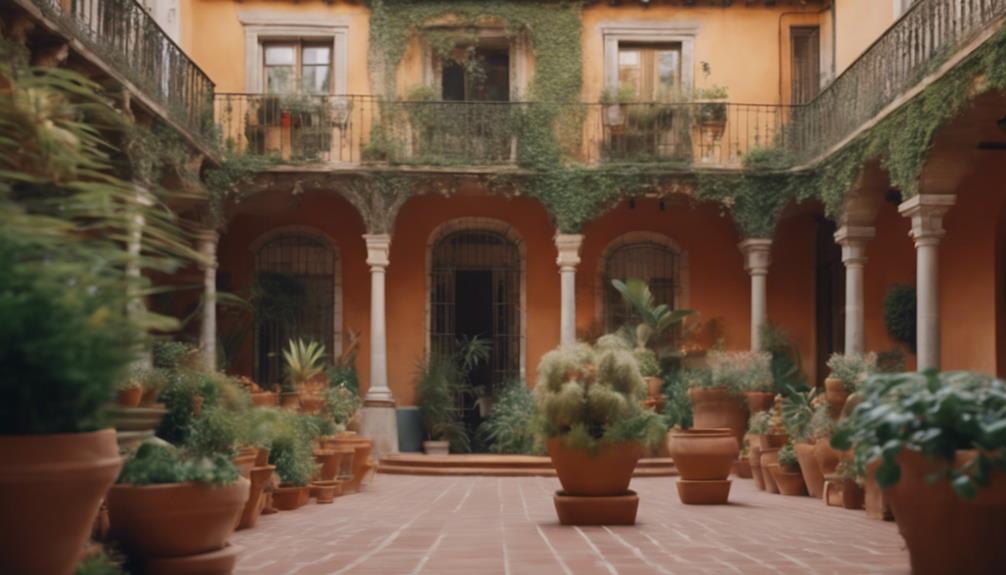
Despite evolving societal norms, Spanish architectural tradition has remarkably demonstrated resilience over time. The unique blend of styles found in Spain's architecture tells a story of diverse influences and rich history.
From the modernist masterpieces of Gaudi to the intricate Moorish designs of Granada, Spain's architectural heritage is both enthralling and enduring.
Iconic landmarks like Casa Batlló, La Sagrada Familia, and the Alhambra Palace stand as proofs to Spain's architectural prowess and cultural significance. These structures not only showcase the skill and creativity of Spanish architects but also serve as magnets for tourists from all corners of the globe.
The ability of Spanish architecture to adapt and endure through changing times is a true reflection of its resilience. As new challenges and trends emerge, Spain's architectural tradition continues to stand strong, preserving its legacy for future generations to appreciate and admire.
Heat-Resistant Designs in Spain

Spanish architectural tradition's resilience is further exemplified through its incorporation of heat-resistant designs, showcasing innovative solutions to combat the intense heat prevalent in the region. In the Basque Country and beyond, architects have honed techniques that not only withstand high temperatures but also enhance the aesthetic appeal of the structures.
- Shaded Courtyards: Spanish architecture often features shaded courtyards that provide a cool retreat from the scorching sun, creating comfortable outdoor spaces for socializing and relaxation.
- Thick Walls: The use of thick walls constructed from materials like adobe or stone helps regulate indoor temperatures, keeping spaces cooler during hot days and warmer during chilly nights.
- Clay Tiles and Stucco: Traditional Spanish buildings utilize materials such as clay tiles and stucco that provide insulation, reflecting heat away from the interiors and maintaining a comfortable atmosphere inside.
Frequently Asked Questions
Does the Siesta Still Exist in Spain?
Yes, the siesta still exists in Spain, but less than 18% of Spaniards now regularly take them. Originating as a break from midday heat, the tradition was common in Spain and Italy, especially during the Franco era.
What Does Siesta Mean in Spanish?
Siesta means a midday nap or rest period in Spanish. It's a time-honored tradition for taking a break after lunch, especially during the hottest part of the day. Despite its history, fewer Spaniards now regularly take siestas.
What Country Shuts Down for Nap Time?
Ever wondered what country shuts down for nap time? Spain, with its siesta tradition, once embraced midday breaks. While less common now, it remains a cultural icon with historical roots in beating the afternoon heat.
How Long Do People Sleep in Siesta?
During a siesta, you typically rest for at least 2 hours to recharge. Spaniards often work from 9 a.m. to 2 p.m., then resume from 4 p.m. to around 8 p.m. Less than 18% of them currently take regular siestas.
Conclusion
You've just scratched the surface of Spain's architectural beauty with 'Azulejos'! These vibrant ceramic tiles not only add a pop of color to buildings, but also serve a practical purpose in the scorching Spanish sun.
So next time you're wandering the streets of Spain, keep an eye out for these stunning tiles and appreciate the perfect blend of aesthetics and functionality.
Who knew staying cool could look so hot?
- About the Author
- Latest Posts
Introducing Ron, the home decor aficionado at ByRetreat, whose passion for creating beautiful and inviting spaces is at the heart of his work. With his deep knowledge of home decor and his innate sense of style, Ron brings a wealth of expertise and a keen eye for detail to the ByRetreat team.
Ron’s love for home decor goes beyond aesthetics; he understands that our surroundings play a significant role in our overall well-being and productivity. With this in mind, Ron is dedicated to transforming remote workspaces into havens of comfort, functionality, and beauty.
Decor
Rustic and Modern Cabinets Galore
Browse through our collection of rustic and modern cabinets for a touch of sophistication in your home.
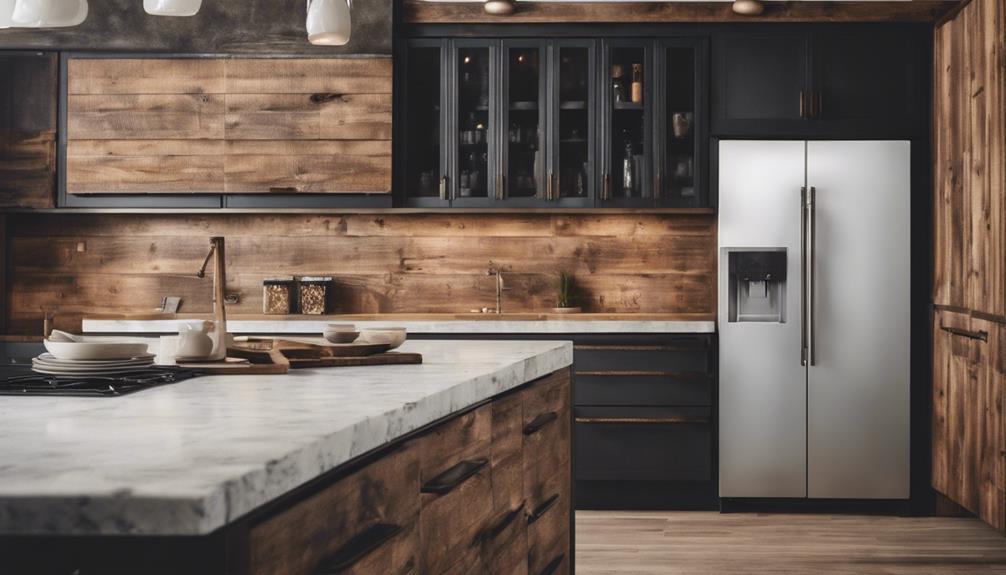
Explore a wide selection of rustic and modern cabinets in our collection. From elegant weathered console cabinets to chic farmhouse wooden wine cabinets, there's something for every style. Discover rustic farmhouse display cabinets, sleek modern classic carved wood sideboards, and more. Each piece offers unique designs to elevate your home décor. Start transforming your space with these exquisite pieces that add both functionality and style.
Key Takeaways
- Explore a diverse selection of rustic farmhouse cabinets with weathered wood and elegant designs.
- Discover modern cabinets featuring clean lines, innovative features, and functional storage options.
- Find a balance between rustic and modern styles with unique pieces like herringbone sideboards and teak wood consoles.
- Embrace industrial and retro vibes with distressed wood, metal, and rattan accent cabinets.
- Whether you prefer a chic contemporary look or a vintage industrial feel, there are cabinets to suit every taste.
Farmhouse Style Cabinet Collection
Explore the exquisite Farmhouse Style Cabinet Collection featuring elegant weathered consoles, French-inspired islands, and rustic sideboard cabinets. These pieces bring a touch of classic charm to your home decor.
The Elegant Weathered Console Cabinet at $2,598.00 offers a sophisticated storage solution. For a more rustic feel, consider the French Country Rustic Sideboard Cabinet priced at $2,498.00. If you're looking for a statement piece, the Elm Top French Island priced at $1,548.00 combines style and functionality seamlessly.
With the Weathered Wood Cabinet at $1,248.00 and the Rustic Painted Pine Sideboard at $1,348.00, you have a variety of options to enhance the farmhouse aesthetic in your living space.
Rustic Storage Cabinet Showcase
Discover a diverse selection of rustic storage cabinets that exude charm and functionality in any living space.
From the Old World Style Narrow Metal Cabinet priced at $1,048.00 to the Rustic Farmhouse Display Cabinet at $4,198.00, there's a wide range to suit various tastes.
The Heavily Distressed Pale Hued Storage Cabinet for $3,498.00 offers a unique aesthetic, while the Rustic Elegance Sideboard Cabinet priced at $2,976.00 combines style and practicality.
Don't miss the Aged Old Pine Painted Buffet Cabinet at $2,548.00, perfect for adding a touch of rustic appeal to your home.
These rustic storage cabinets provide ample storage space while adding a rustic flair to your decor.
Modern Cabinet Selection
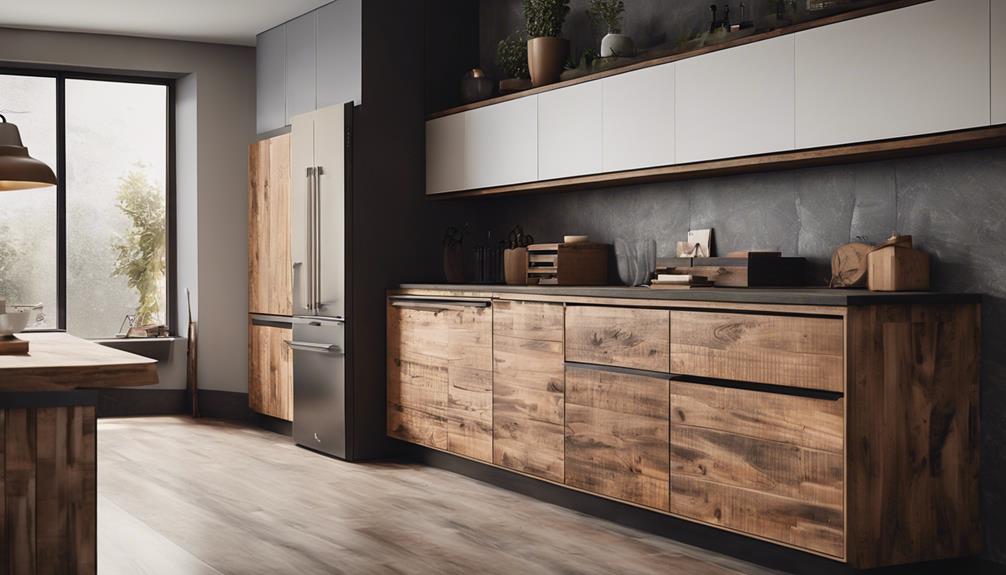
Check out the diverse selection of modern cabinets available to enhance your living space. From sleek and minimalist designs to bold statement pieces, modern cabinets bring a contemporary flair to any room.
Consider the Scaled Pattern Console Cabinet for a unique geometric touch, or opt for the Modern Classic Carved Wood Sideboard to add a touch of elegance. If you prefer a more understated look, the Teak Wood Farmhouse Console Cabinet might be the perfect choice.
With clean lines and innovative features, modern cabinets not only provide functional storage but also serve as stylish focal points in your home. Upgrade your space with one of these modern cabinet options to create a chic and sophisticated atmosphere.
Chic & Contemporary Cabinet Picks
Enhance your living space with chic and contemporary cabinet selections that exude modern elegance and functionality.
Opt for the 'Modern Farmhouse 4 Door Herringbone Sideboard' at $1,998.00 for a stylish storage solution.
If you prefer a more casual look, the 'Casual Classics Farmhouse Sideboard Cabinet' priced at $1,698.00 offers a blend of charm and practicality.
For a coastal vibe, consider the 'Coastal Chic Painted Wood Console Table' priced at $1,198.00, perfect for a beachy aesthetic.
If you're a wine enthusiast, the 'Chic Farmhouse Wooden Wine Cabinet' at $448.00 combines sophistication with storage.
Industrial & Retro Cabinet Highlights
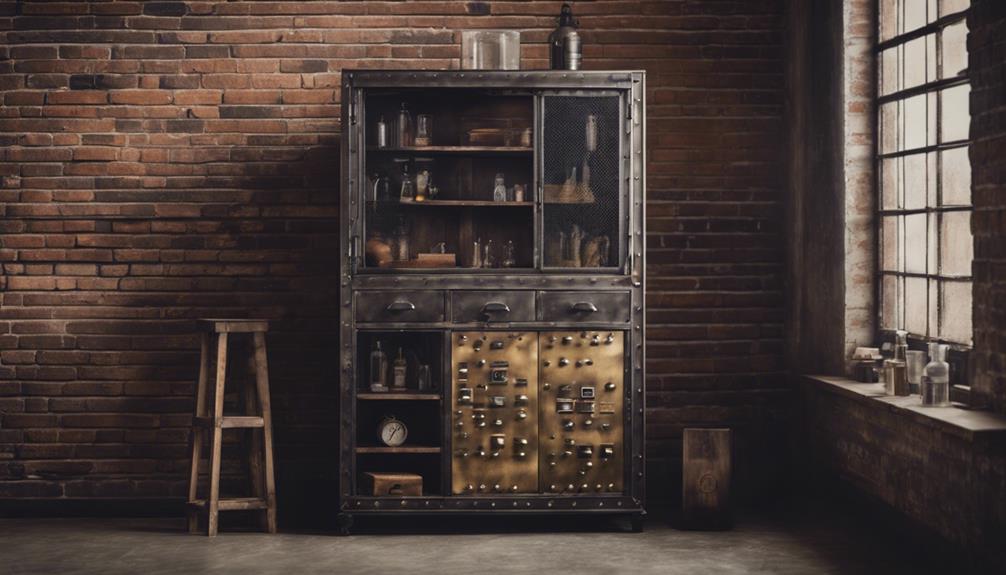
To explore unique cabinet options with an industrial or retro flair, consider the following highlights:
- Distressed Wood and Metal Curio Cabinet – $1,998.00: This cabinet combines the rustic charm of distressed wood with the edgy appeal of metal accents, creating a standout piece for your space.
- Dark Mango Wood Console Cabinet – $1,898.00: The dark mango wood of this cabinet exudes a rich and luxurious feel, while the industrial design elements add a touch of vintage sophistication.
- Retro Wood and Rattan Accent Cabinet – $189.00: With a nod to retro aesthetics, this cabinet features a blend of wood and rattan materials, making it a chic and affordable option for adding a touch of nostalgia to your decor.
Conclusion
Now that you've explored our rustic and modern cabinets galore, it's time to bring home the perfect piece to elevate your living space.
Remember, 'a house is made of walls and beams, but a home is made of love and dreams.'
Choose a cabinet that speaks to your style and personality, and watch as it transforms your space into a cozy retreat or a modern sanctuary.
Let your imagination soar with our diverse collection of cabinets!
- About the Author
- Latest Posts
Introducing Ron, the home decor aficionado at ByRetreat, whose passion for creating beautiful and inviting spaces is at the heart of his work. With his deep knowledge of home decor and his innate sense of style, Ron brings a wealth of expertise and a keen eye for detail to the ByRetreat team.
Ron’s love for home decor goes beyond aesthetics; he understands that our surroundings play a significant role in our overall well-being and productivity. With this in mind, Ron is dedicated to transforming remote workspaces into havens of comfort, functionality, and beauty.
Eclectic Style
Granny Chic Gone Wild: The Style Revolution That's Making Millennials Swoon!
Intrigued by Granny Chic? Discover how this style revolution is captivating Millennials with its vintage charm and modern twist, leaving fashion enthusiasts wanting more.

If you're attracted to vintage charm with a modern twist, Grandmillennial style, fondly known as Granny Chic, will captivate you. Think crochet sweaters, heirloom jewelry, and departure from mainstream fashion. Millennials are embracing this style revolution, opting for unique pieces that transport them back in time with a contemporary edge. From brooches to vintage clip earrings, the influence of Granny Chic is evident in designer shows and street fashion. Sustainability concerns and digital media have fueled this trend, promoting conscious consumption and eco-friendly choices. Stay tuned to uncover more about this alluring style revolution.
Key Takeaways
- Millennials are embracing vintage-inspired granny chic fashion.
- The trend includes unique accessories like eyeglass chains and vintage clip earrings.
- Grandmillennial style blends vintage charm with a modern twist.
- Sustainability influences the shift towards second-hand and vintage clothing.
- Digital media platforms are popularizing the granny chic aesthetic.
Grand Millennial Style Characteristics
Grand millennial style characteristics include vintage-inspired elements like crochet sweaters and eyeglass chains for a nostalgic touch. Young adults are embracing granny chic accessories, such as vintage clip earrings and heirloom-inspired jewelry, to express their personal style.
These modest styles offer a departure from mainstream trends, allowing individuals to stand out with unique pieces that exude character and charm. The allure of grand millennial fashion lies in its ability to transport wearers back in time while adding a contemporary twist.
Trends in Grandmillennial Fashion
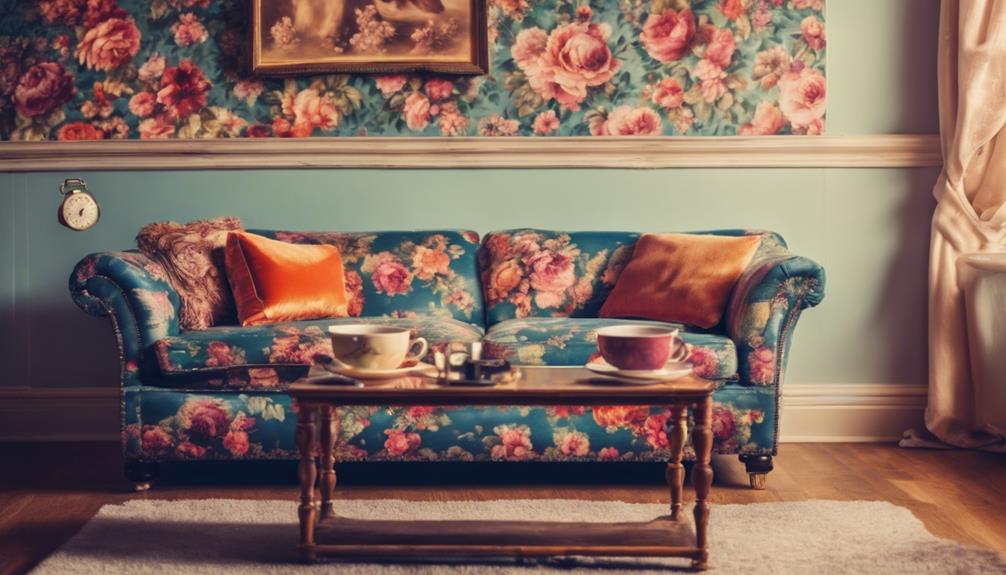
Embracing vintage-inspired accessories and jewelry is a key trend in the world of grandmillennial fashion. Young adults are wholeheartedly embracing the granny chic look, seeking out pieces like women's brooches, glasses chains, vintage clip earrings, and lockets to complete their outfits.
The resurgence of modest styles and traditional jewelry reflects a broader interest in vintage style in general. In both designer runway shows and street style, the influence of grandmillennial fashion trends is palpable, with designers incorporating heirloom-inspired pieces into their collections.
The surge in searches for items like brooches, glasses chains, vintage earrings, and lockets points to a growing appreciation for the granny chic aesthetic among millennials. These accessories aren't only making a statement on the runway but are also becoming staples in everyday wardrobes, blending nostalgia with a contemporary twist.
The fusion of vintage charm with modern sensibilities is defining a new wave of style that celebrates the beauty of the past while staying relevant in the present fashion landscape.
Influence of Digital Media and Sustainability

How has the rise of digital media platforms impacted the sustainability-focused Granny Chic fashion trend among younger generations? Social media platforms like YouTube, TikTok, and Instagram have played a pivotal role in popularizing Granny Chic fashion among young adults. As sustainability concerns grow, more individuals are turning to vintage pieces and second-hand fashion, aligning perfectly with the eco-friendly ethos of Granny Chic. Celebrities like Billie Eilish advocating for environmental support have further fueled this trend, influencing a shift towards more conscious consumption.
To explore further into the influence of digital media and sustainability on Granny Chic fashion, consider the following table:
| Trends in Granny Chic Fashion | ||
|---|---|---|
| Sustainability Emphasis | Increased Searches for Vintage Pieces | Young Adults Embracing Second-Hand Fashion |
| The focus on sustainability has led to a surge in interest in Granny Chic. | Searches for vintage pieces have witnessed a significant increase. | Younger generations are actively embracing second-hand fashion for its eco-friendly appeal. |
| Environmental Impact Awareness | Promotion of Unique Style Choices on Social Media | |
| Individuals are increasingly mindful of the environmental impact of their fashion choices. | Social media platforms are showcasing distinctive Granny Chic style choices, influencing a broader audience. |
Lifestyle Aspects of Grandmillennial Trend
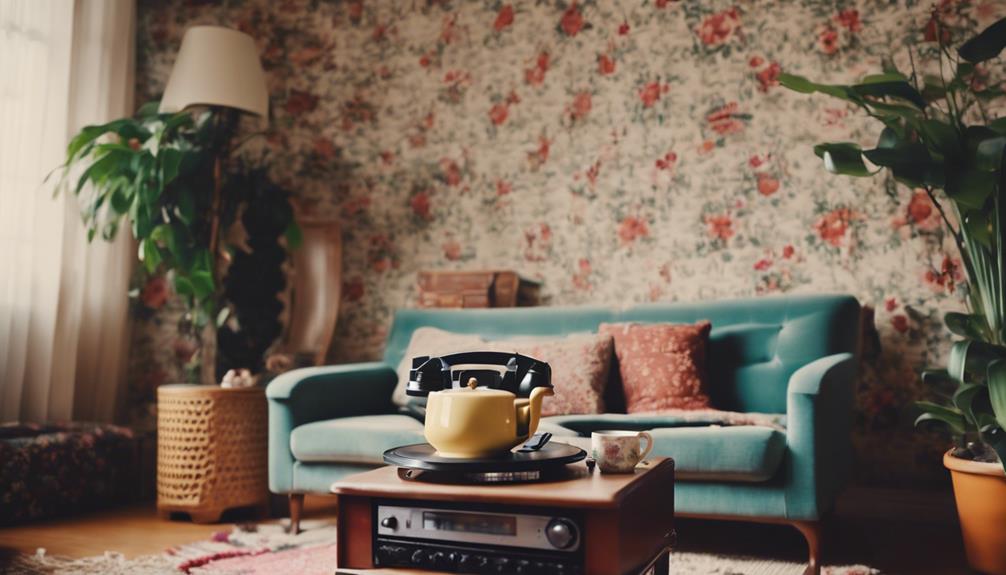
The grandmillennial trend embodies a return to traditional crafts and a more intentional, sustainable approach to lifestyle choices. Young adults are embracing the granny chic movement by incorporating vintage pieces and vintage-inspired clothing into their wardrobes, exuding a sense of modest style with a nod to the past.
Within the grandmillennial lifestyle, there's a strong emphasis on conscious wardrobe decisions, encouraging individuals to opt for sustainable fashion choices that align with their values.
- Embracing the granny: Millennials are finding joy in embracing the granny chic aesthetic, infusing their spaces with vintage charm and classic pieces.
- Traditional crafts revival: Crocheting, knitting, and other traditional crafts are gaining popularity among grandmillennial enthusiasts, fostering creativity and a sense of connection to the past.
- Intentional living: Grandmillennials prioritize quality over quantity, focusing on intentional living practices that promote mindfulness and a more meaningful way of life.
Millennial Adoption of Grandmillennial Style
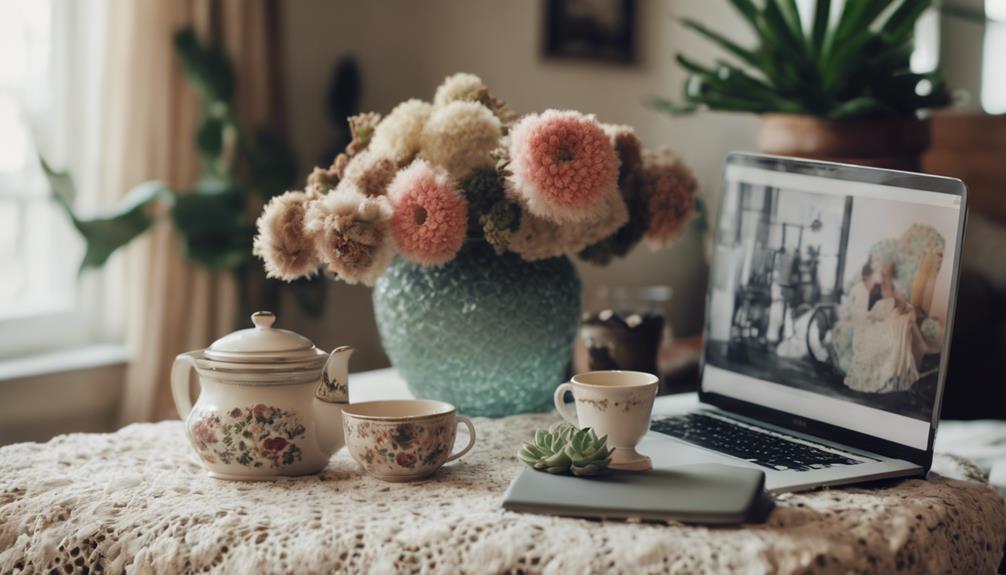
Vintage-inspired individuals are increasingly drawn towards the grandmillennial style, moving from simplistic to retro-inspired aesthetics in their fashion choices. Embracing elegant looks and humble styles, vintage-inspired individuals are showing a preference for classic pieces over contemporary trends like slim-fit jeans.
This evolution isn't just about fashion; it's a mindful decision towards a more eco-friendly wardrobe. By choosing pre-loved fashion and vintage pieces, vintage-inspired individuals are lessening their environmental footprint and adding unique charm to their outfits.
The grandmillennial style isn't only about clothing but also extends to home decor, displaying a fondness for timeless grace and elaborate designs. Younger individuals are actively engaging in vintage and thrift store shopping excursions, searching for one-of-a-kind pieces that narrate a tale.
This change reflects a cultural shift towards valuing the past while forging a more sustainable future.
Frequently Asked Questions
Why Is Grandma Chic Coming Back?
Grandma chic is making a comeback because of a longing for uniqueness and individuality in living spaces. This trend involves vintage and heirloom pieces for a personalized touch, rejecting minimalism in favor of eclectic interiors that captivate.
What Does Granny Chic Mean?
You asked, "What does granny chic mean?" Granny chic blends vintage charm with a modern twist, embracing old-school design elements like floral patterns and heirloom jewelry. It's all about individuality and uniqueness in fashion and decor.
What Is the Grandma Design Trend?
The grandma design trend, also known as granny chic, blends vintage aesthetics with a modern twist for a unique look. It incorporates elements like floral wallpaper, rich wood furniture, and eclectic patterns for personalized living spaces.
What Does Grandmillennial Style Mean?
You know grandmillennial style as a blend of modern and traditional design elements. It's about embracing vintage-inspired pieces like crochet sweaters and heirloom jewelry for a unique, standout look. It's all about that character and charm!
Conclusion
So, what's the deal with Grandmillennial style?
Well, did you know that 67% of millennials say they're drawn to the vintage-inspired, cozy aesthetic?
With its blend of nostalgia and modern flair, it's no wonder this trend is taking the fashion world by storm.
So go ahead, embrace your inner granny chic and join the revolution that's making millennials swoon!
- About the Author
- Latest Posts
Introducing Ron, the home decor aficionado at ByRetreat, whose passion for creating beautiful and inviting spaces is at the heart of his work. With his deep knowledge of home decor and his innate sense of style, Ron brings a wealth of expertise and a keen eye for detail to the ByRetreat team.
Ron’s love for home decor goes beyond aesthetics; he understands that our surroundings play a significant role in our overall well-being and productivity. With this in mind, Ron is dedicated to transforming remote workspaces into havens of comfort, functionality, and beauty.
-

 Vetted5 hours ago
Vetted5 hours ago15 Best Plants for Large Pots to Transform Your Outdoor Space
-

 Vetted2 days ago
Vetted2 days ago15 Best Folding Beds for Small Spaces – Space-Saving Solutions for Comfort and Convenience
-

 Vetted1 day ago
Vetted1 day ago15 Best Waterproof Flooring Options for Your Bathroom – Ultimate Guide & Reviews
-

 Vetted6 days ago
Vetted6 days ago15 Best Grocery Carts to Make Shopping a Breeze
-

 Vetted2 weeks ago
Vetted2 weeks ago15 Best Gravel for Driveway: The Ultimate Guide for a Durable and Stunning Entrance
-

 Vetted4 days ago
Vetted4 days ago15 Best Steam Generators for Showering Bliss: Reviewed & Rated
-

 Beginners Guides3 weeks ago
Beginners Guides3 weeks agoI Inhaled Vinegar Fumes
-

 Vetted2 weeks ago
Vetted2 weeks ago15 Best Hot Tubs of 2024: Luxurious Relaxation at Your Fingertips

























